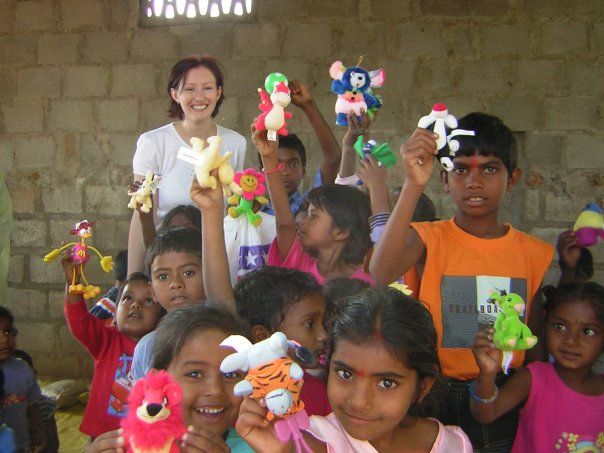Why are there so many acronyms in ELT (English Language Teaching)?
Yes, a lot of them are due to political correctness rather than a difference in meaning, (we'll get to that in a minute), but in the case of ESL, (English as a Second Language), and EFL, (English as a Foreign Language), there are some very clear distinctions which have implications for teaching and learning.
Let's start with the situation that is most common for teachers in the United States, Australia, Canada, New Zealand and the UK: ESL.
ESL refers to an environment where the students have a variety of different native languages or L1s (First Languages). This mixture of littlies with no common language can present issues with socio-emotional well being, as the kids may feel anxious about their lack of understanding or frustration with difficulties in making friends and communicating. As teachers, we need to pay special attention to ensure that each child develops a peer group or some sort of social support network. We also need to make sure that their L1 and home culture is valued, and that parents recognise the benefit in maintaining the L1 in the home. (You can look at articles here, here and here which all highlight benefits of bilingualism.)
ESL teaching is usually not grammar-heavy, but instead often involves teaching via CLIL (Content and Language Integrated Learning). The aim for ESL learners is usually to obtain native-like fluency, so that they may study in a mainstream classroom and/or go on to pursue university studies and a career in an English speaking country. CLIL is an effective method for achieving this.
The best thing about ESL teaching is that students have an intrinsic motivation to learn the language. They want to communicate! They want to make friends, they want to watch TV, and they want to tell you all about their weekend =)
The ESL acronym is less widely used these days because that specific choice of words assumes that the learner is only learning their second language. In reality, a student from the state of Andhra Pradesh in India, for example, may speak or understand the mother tongue of their state, (Telugu), the co-official language of the state, (Urdu), as well as the more widely spoken 'national' language, (Hindi), and perhaps even the language of a neighbouring state, (for example, Banjara, Tamil, Kannada, Marathi, Oriya... the list goes on!). So to call these students 'Second Language Learners' is a little insulting as it doesn't recognise how knowledgeable and experienced the students are in regards to language learning.
 |
| School children in Venkatadri Palem, Andhra Pradesh, India. Wait a minute... who's that pretty young lady up the back? =) |
This is because members of Australian Aboriginal communities may speak the native languages of the region, (for example, in Central Australia there are three main language families, each of which has a number of dialects), but they may also speak Aboriginal English, which is a recognised dialect, with similarities to SAE, (Standard Australian English), but with its own grammar structure.
In the past, English settlers believed that Aboriginal English was a corrupted lower form of English, but today we can see that this is simply not true. It has the same amount of complexities in meaning and usage as the standard form. Depending on the background of the learners, EAL/D teaching could be likened to both ESL and EFL.
We use this term when all of the English learners speak the same native language or L1. Usually, the teacher will be teaching in a non-English speaking country when this happens. In my case, I teach English to Mexicans, who all speak Spanish.
 |
| Oh look! Another pretty lady! In Mexico this time, and looking about 8 years older =) |
From a cognitive perspective, however, there are other opportunities which are being missed by adopting a 100% Zero English Approach. There are a lot of cognates in Spanish and English, for example, which we can use to connect to prior knowledge of vocabulary in the L1. Grammar structures are also similar between the two languages, so I find that it can be useful to start with a grammar structure in Spanish and then show how it changes when the same thing is expressed in English. Comparing and contrasting, right? So, when used effectively, I don't think the L1 should be banned in the EFL classroom, and I'm not alone. Just use it wisely!
 |
| There she is again... giving out cupcakes. How educational! |
It's a constant battle for some students! It's excusable for the little ones as they are usually lower level learners with much smaller vocabularies, but it drives me nuts when my advanced level students speak in Spanish. For them, it is not an issue of lack of confidence or vocabulary; it is pure laziness. There are some good tips floating around the internet about helping to discourage L1 use, but I wanted to show you some additional silly fixes I have been using in my English conversation classes =)
My first attempt involved the 'Say it it English' cards.
The basis of the idea was to transfer the responsibility of monitoring language use over to the students. I was so sick of reminding them to 'Say it in English', so I thought a visual reminder mind help. They each have one of the 'Say it in English' cards, and whenever they hear a classmate speaking in Spanish, they just hold up the card to remind them not to.
Here is what is looks like when the whole class remembers to do it.
Here is what is looks like when the whole class remembers to do it.
It worked with one of my classes, but not the other.
So I racked my brains for another idea... and remembered an idea I had seen on a teacher's blog a week or so prior: Respectacles.
The teacher had taken a pair of spectacles and repurposed them as 'Respectacles' (much prettier than mine!). She had used them in a lower grades classroom as a reward for students who demonstrated respect. The little kids loved wearing them. But I teach teenagers! So I used the idea in reverse: disrespect your classmates, (who have paid good money to be in an English speaking class), by speaking Spanish, and you get to wear the Respectacles for 5 minutes =) Before we put the Respectacles into action, we had a little discussion about what constitutes respect in our classroom. In addition to speaking in Spanish, they opted for no name calling and no interrupting when someone else is speaking. Just what I would have chosen!
I'm pleased to report that this method actually yielded results!
I guess nobody wants to look like a dork =)
Here is my colleague modeling the Respectacles during a staff meeting.
(He had been acting as a Pronunciation Coach earlier, which explains the P.C. on his shirt!)
So to sum up, there are just two main types of English Language Learner: those who share a native language with their fellow learners, and those who do not. Don't let the acronyms confuse you! And remember to be prepared for different behavioural issues with each group =)
So I racked my brains for another idea... and remembered an idea I had seen on a teacher's blog a week or so prior: Respectacles.
 |
| I wish I could remember where I found this idea! Please let me know if it was you! |
I'm pleased to report that this method actually yielded results!
I guess nobody wants to look like a dork =)
Here is my colleague modeling the Respectacles during a staff meeting.
(He had been acting as a Pronunciation Coach earlier, which explains the P.C. on his shirt!)
So to sum up, there are just two main types of English Language Learner: those who share a native language with their fellow learners, and those who do not. Don't let the acronyms confuse you! And remember to be prepared for different behavioural issues with each group =)
















This is very inspiring and very informative!
ReplyDeleteI'm your newest follower. You are on an amazing adventure. I'm looking forward to reading about it.
ReplyDeleteKelly @ I'm Not Your Grandpa, I'm Your Teacher
This comment has been removed by the author.
ReplyDeleteThis is such an inspiring post. Good thing you have a passion in teaching English. Here in the Philippines, our system of Education has also evolved into something different. Other than traditional schools, we already have institutions like this - http://talkshop.ph/ where they teach students proper grammar and personality development. It is good to know that people have the passion to share their knowledge.
ReplyDeleteI LIKE IT
ReplyDelete